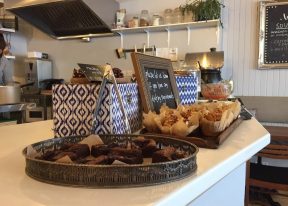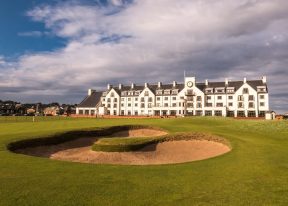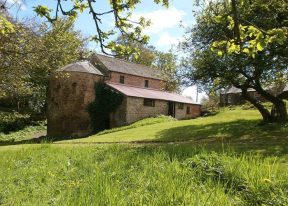Carnoustie has a long and rich golfing heritage. Golf has been played over the links at Carnoustie since the 1500s but the Carnoustie Championship Course came into being in the late 1800s. Carnoustie has had a long and illustrious association with The Open Championship since 1931 and has hosted eight Opens.
This guide features two trails, one short and one long.
The short trail is about a mile and a half long while the long trail is around four miles, not including the distance to Barry Mill, which is an extra two miles either way.
Both trails are circular, starting at the Carnoustie Golf Hotel, but you can join or leave them at any stage.

Follow the Carnoustie Heritage Trail
Starting at Carnoustie Golf Hotel, this heritage trail will take you on a journey through Carnoustie’s rich history. Take your pick from the short one and a half mile trail, or the longer four mile trail.
See the stops (short trail)
- 1. Simpson's Golf Shop
- 2. Erskine United Free Church
- 3. Kinloch Primary School
- 4. Carnoustie Church
- 5. Auld Nick
- 6. War memorial
- 7. Dibble Tree
- 8. The 19th Hole
- 9. Dibble Tree Theatre
- 10. First Feu Cottage
- 11. Fairways Garage
- 12. Bank of Scotland
- 13. Council chambers
- 14. Turret
- 15. The Point
- 16. Kinloch Arms
- 17. Public library
- 18. Memorial garden
- 19. Old bank building
- 20. Edwardian cottages
- 21. Station Hotel
- 22. Salmon Bothy
- 23. Leisure Centre
- 24. Drinking fountain
- 25. Bruce Hotel
The Simpson family first made its mark on Carnoustie when Robert, aged 22, was appointed as “keeper of the green” in 1883.
A year later his brother, Jack, won The Open at Prestwick and, along with another brother, Archie, they established a club makers’ shop on Links Parade.
Walk under the railway bridge up Links Avenue.
As you cross Kinloch Street, look right and 100 metres down on the north side is the Erskine United Free Church, the oldest church building in Carnoustie, built in 1810.
When you reach the junction at the top you are standing alongside the grounds of Kinloch Primary School, opened in 1878 as Carnoustie Public School and last used as a school in 2008.
On the north side of Dundee Street you will see Carnoustie Church built in 1902 by public subscription. However, the congregation were unable to raise enough funds, so the steeple was never completed.
Turn right towards the centre of the town, passing on your left shops originally built in 1888 which still retain their original iron balustrades on the upper floor.
You will arrive at the ‘Auld Nick’ which originally housed Carnoustie’s first police office and cells and which was in use until the Police Station was moved further west to Thistle Street.
Next is the War Memorial, one of the finest in Scotland. It was designed by local architect James Prain Bruce and was dedicated in 1926.
It features a sculpture of the Unknown Soldier by Thomas Beattie and commemorates the 142 soldiers who lost their lives in two world wars and the two Carnoustie Victoria Cross winners.
Tammas Louson, a loomwright from Barry, was returning home one evening in 1797 and after passing the now demolished Point Inn, at the bottom of Lochty Street, he took a rest and fell asleep.
Upon waking and feeling especially refreshed, he decided to approach the owner of the land about renting a small plot. In 1798, while planting vegetables on his new land, Louson left a dibble stick in the ground which he later found had sprouted leaves.
The resulting ‘Dibble Tree’, a magnificent Crack Willow, can still be seen, down Ferrier Street on the left.
Looking down Ferrier Street you will see on the right the 19th Hole public house.
Formerly a boatyard connected to the sea by a canal where the street is now, before the new railway, opened in 1838, cut it off.
Further along Dundee Street, you will spot the Dibble Tree Theatre, down a lane on your right. This is the home of Carnoustie Theatre Club’s talented amateur dramatists.
It was originally a joiner’s workshop and was converted to a theatre in 1999. The 48 seats in the theatre are from the now defunct Regal Cinema in neighbouring Broughty Ferry.
Further east along Dundee Street, you will pass First Feu Cottage, site of Tammas Louson’s original home in Carnoustie. A direct descendant of Tammas Louson still lives in the cottage.
Walking east along the High Street you will pass the crossroads known as The Cross, once the hub of the town.
After a while on your right you will come to the site of the former Fairways Garage, an art deco style building.
Opposite Fairways is the old Bank of Scotland building which not only housed the mahogany-lined bank but also an ostentatious house for the manager.
It is now a private residence.
Further east, the imposing Council Chambers, built in 1898, were designed by James Prain Bruce, the same man who designed the War Memorial.
Not all agreed with the design choice – some described it as ‘a riotous extravagance’ at the time. He also designed many of the imposing large houses around Carnoustie.
Bruce’s style almost always included a turret – confirmed if you turn and look back along the High Street to the large building at the Cross at the bottom of Queen Street.
What is now the car park behind the Council Chambers on Lochty Street was once called ‘The Point‘ and is the oldest part of the town.
If you go up Lochty Street for a hundred yards, you will see, at the entrance to Philip Street, the oldest cottages in Carnoustie, built in 1800, and now joined as one.
On the south side of the High Street next to the Fairways Garage stands the Kinloch Arms Hotel, the first building in Carnoustie to be fitted with electricity in 1893.
Next on the right is the Public Library, built in 1976, where upstairs you can see the regalia for the Provost of Carnoustie, including the chain and robes.
Continuing along the High Street, opposite the end of Station Road, you will come to the memorial garden dedicated to the greatly loved and admired Dr George McConnell, who came from Ireland and set up one of the medical practices in Carnoustie.
The garden was dedicated to him in 1950 following his death in 1948.
Now divided into residential villas, the imposing building opposite the top of Station Road was once the Clydesdale Bank building. Before that, it was the City of Glasgow Bank building, which is known for its spectacular collapse in October 1878. All the Directors were subsequently jailed.
To the east is the Panbride side of town. Originally it was one of two parishes which now make up Carnoustie, the other is Barry. The Feus (rental agreements) stated that no machinery was permitted, so unlike the rest of Carnoustie, which has had industries both large and small, Panbride Parish was, and remains, largely residential.
As you walk down Station Road, look left along Ireland Street, noting the row of Edwardian cottages again designed by James Prain Bruce, and typical of Carnoustie.
The arrival of the railway in 1838 divided Carnoustie physically but brought opportunity and prosperity for some.
The Station Hotel, by the side of the railway station, was built in 1840 and named The Railway Hotel.
Later the name was changed to the Panmure Arms Hotel and finally to The Station Hotel.
Located on the western side of the railway signal box is a small ornamental garden surrounded by stone walls.
This is all that remains of the Salmon Bothy, in use until the 1960s. Nets were stretched across the River Tay in Carnoustie Bay to catch salmon which were prepared and packed in ice at the bothy by local women, and put on special overnight express trains to Billingsgate Market in London.
Turn right and stroll along the beach path towards the Leisure Centre where you will come to the Art Deco styled ‘Beach Hall’, as it was named when built.
The opening of this hall in June 1934 meant that the famous Carnoustie Pierrot shows, once played under canvas on the beach, could be staged indoors.
Further along, in front of the tennis courts, you will see a reminder of the town’s once thriving shoe and boot trade, in the form of a memorial drinking fountain.
This was erected in memory of John Winter, shoe manufacturer, by his son, the Provost.
At the bottom of Ferrier Street is a large building, originally the Bruce Hotel.
Built in 1892 and owned by Mrs Mary Bruce it saw many famous guests from all over the world, including Charlie Chaplin, Margaret Thatcher, Yehudi Menuhin, and in the 1930’s Edward Prince of Wales, as well as many of the legendary golfers who graced the Open Championships held here during the twentieth century.
You are now a short walk from the starting point at the Carnoustie Golf Hotel.
See the stops (long trail)
- A. Coastguard Station
- B. Westhaven
- C. Panbride House
- D. Easthaven
- E. Craigmill Burn
- F. Church
- G. Carnoustie House Grounds
- H. Thistle Street
- I. Barry Mill
- J. Campanile Tower
- K. Railway
Leaving the Carnoustie Golf Hotel, head towards the sea. Travel east along the beach path which goes to Arbroath and beyond.
After 3 hundred yards you will come to the Coastguard station. The station building is now demolished, but for over 300 years volunteers maintained watch, in all weathers, ready to work with the lifeboats at Arbroath and Broughty Ferry should disaster strike along the coast or out at sea.
The notorious Abertay or Gaa Sands, about a mile offshore, are very dangerous and clearly visible at low tide. In front of the Coastguard station you will spot the now redundant gun position, constructed during the 1914-18 war to protect the mouth of the River Tay, Dundee and Perth from any seaborne enemies.
You are now entering the village of Westhaven, larger and more prosperous than neighbouring Easthaven, although younger (it is first recorded in 1507).
It is known as a safe harbour for the small fleet of inshore boats, and in earlier times for sloops carrying coal down the coast.
Look for three rows of cottages in Westhaven called Long Row, East Row, and West Row.
Continue eastwards along the cycle path, through the houses, over the railway bridge and eastwards along the Arbroath road.
This brings you to Panbride House on the left, opposite the David Murray yard.
Just past the entrance you will find a bridge over the Craigmill Burn.
If you continue east, crossing the bridge and re-joining the cycle path, after roughly one mile you will come to Easthaven which, though smaller than Westhaven, can boast greater antiquity, being first noted in the last year of the reign of King William the Lion, King of the Scots 1165-1214.
Return to the Craigmill Den signpost. Follow the path by the burn and carry on up the hill where you will find the leafy den with the burn flowing through it. This is where a water mill, now disappeared, was one of four on the Craigmill Burn for the bleaching works downstream.
This site is rumoured to be the setting for James Robertson’s fantastical novel ‘The Testament of Gideon Mack.’ Strike westwards and climb the hill out of the Den.
You will come to the older of two churches for Panbride. This one, in the old hamlet of Newton Panbride, still has the ‘Jougs’ (collar manacle) for punishing wrongdoers on Sundays.
In the graveyard surrounding the church is a large memorial to the 36 Panbride men who lost their lives in the First World War – a devastating number in such a small community.
Continue westwards down towards Carnoustie, and cross the main road to progress along Newton Road.
Following the sign to Queen Street you will arrive at Carnoustie House Grounds. Carnoustie House was built by Major William Philips in 1792. The house was demolished following a fire in the 1950s.
A large and popular park, Carnoustie House Grounds is where the famous annual town Gala is held.
Continue through the park until you meet West Path. Turn left and go down the hill past the raised area on the left once known as ‘Lovers Brae’ where young gents would woo their lady friends.
Look right along Thistle Street to spot the rows of cottages built by John Winter, the shoe factory owner, for his workers.
Cross the main road, which can take you westwards via the village of Barry to Barry Mill, two miles away, the only remaining mill of four originally situated on the Barry Burn and on this site since at least 1539.
The mill was acquired by the National Trust for Scotland in 1988 and is in full working order.
Proceed down Camus Street and when crossing Kinloch Street, look to your right to see a magnificent Italianate campanile tower. In 1857 James Smieton opened Panmure Works, a state-of-the-art facility, which at its height had 600 employees, contained 400 modern power looms and produced six million yards of linen and jute annually.
Smieton also built housing in the surrounding area for his employees. In 1865, he opened the Panmure Works Institute on Kinloch Street for the education and recreation of his workers.
This building, notable for the tower, is one of the tallest buildings in Carnoustie. Today it is managed by Angus Council as a resource centre for organisations within the burgh.
Walking down Golf Street you will arrive at the railway. You can cross the bridge and turn right onto the path to Monifieth, or continue down to Links Parade and the Carnoustie Golf Hotel.
Alternatively, turn left along Taymouth Street until you reach Links Avenue. Use the subway to return to the Carnoustie Golf Hotel, turn right onto the path to Monifieth, or head towards the sea and southwards to extensive walks along the beach and links paths, winding through the Championship and Buddon golf courses towards Buddon Ness and the Buddon Ness lighthouses. These stone structures were built in 1866 replacing previous wooden ones.
Carnoustie Heritage Trail maps


Inspiration for your visit
Find out what there is to see and do when visiting Carnoustie.
Take a look at places to enjoy a bite to eat in Carnoustie.
Search for the perfect place to lay your head in Carnoustie.
Enjoy a day out in the coastal town of Carnoustie.




